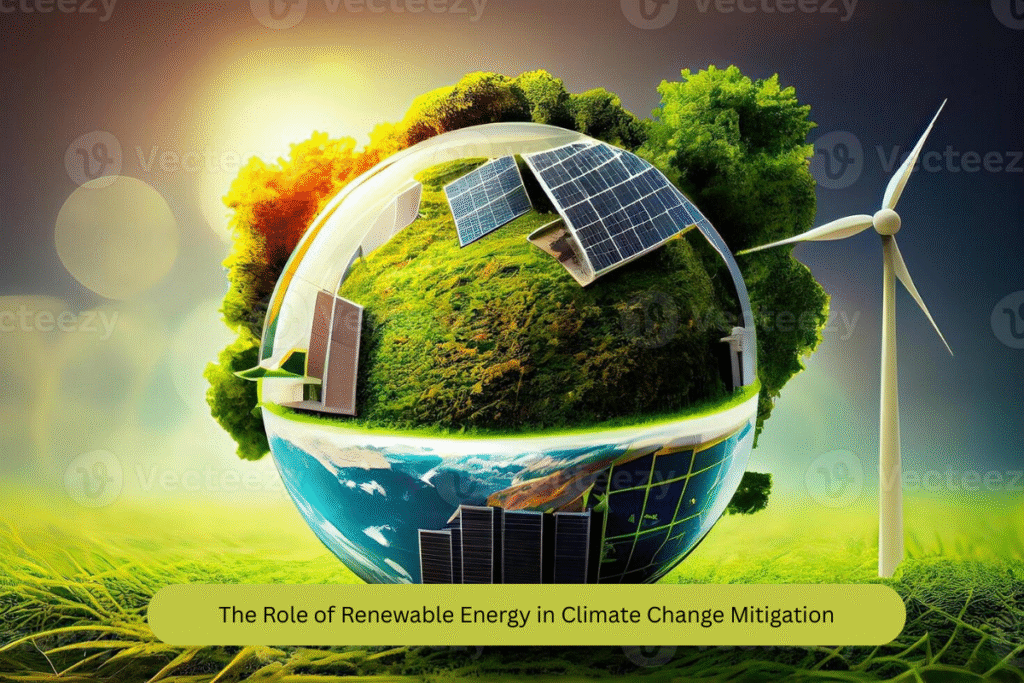
As the world faces the growing threat of climate change, the transition to renewable energy has become a critical component in global efforts to reduce greenhouse gas emissions. Renewable energy sources, such as solar, wind, hydro, and geothermal, are seen as key players in the fight against climate change, offering sustainable, clean alternatives to fossil fuels. This article delves into the role of renewable energy in climate change mitigation, exploring its benefits, challenges, and the path forward.
1. Understanding Renewable Energy and Climate Change Mitigation
Renewable energy is derived from natural sources that are replenished naturally, such as sunlight, wind, rain, tides, and geothermal heat. Unlike fossil fuels (coal, oil, and natural gas), renewable energy sources produce little to no greenhouse gas emissions, making them essential for climate change mitigation.
Climate change mitigation refers to efforts to reduce or prevent the emission of greenhouse gases to slow the rate of global warming. Shifting from fossil fuels to renewable energy is one of the most effective ways to achieve this goal.
2. How Renewable Energy Contributes to Climate Change Mitigation
a. Reduction of Greenhouse Gas Emissions
The burning of fossil fuels for electricity, heat, and transportation is a major source of carbon dioxide (CO2) and other greenhouse gases, which contribute to global warming. Renewable energy, by contrast, generates electricity with little to no carbon emissions.
- Solar Energy: Solar power harnesses sunlight through photovoltaic panels to produce electricity. It emits no greenhouse gases during operation, making it one of the cleanest energy sources available.
- Wind Energy: Wind turbines convert wind energy into electricity. Wind energy generation produces no emissions and is scalable, making it an ideal solution for large-scale power generation.
- Hydropower: Hydropower uses the flow of water to generate electricity. Although large hydropower plants may have environmental impacts, small-scale hydropower and modern practices minimize the carbon footprint of this renewable energy source.
- Geothermal Energy: Geothermal power taps into the heat stored beneath the Earth’s surface to generate electricity. Geothermal plants emit very low amounts of greenhouse gases compared to fossil fuel plants.
By replacing fossil fuels with renewable energy sources, cities and industries can significantly reduce their carbon footprints.
b. Displacement of Fossil Fuels
Renewable energy technologies help displace the use of fossil fuels in electricity generation, transportation, and heating. The adoption of electric vehicles powered by renewable electricity, for instance, can reduce emissions from the transportation sector—a major contributor to global greenhouse gas emissions.
Renewables can also power industrial processes, reducing the need for coal or natural gas in manufacturing and production.
c. Energy Independence and Security
Renewable energy sources are locally available, which means countries and regions can reduce their dependence on imported fossil fuels. This not only strengthens energy security but also reduces the carbon footprint associated with transportation and supply chains for fossil fuels.
In the context of climate change mitigation, energy independence supports the resilience of countries and communities in the face of global energy crises and environmental challenges.
3. The Economic Benefits of Renewable Energy
a. Job Creation
The renewable energy sector has seen significant growth in recent years, creating millions of jobs worldwide. The development, installation, and maintenance of renewable energy infrastructure—such as solar farms, wind turbines, and energy storage systems—generate new employment opportunities.
- Manufacturing Jobs: Production of solar panels, wind turbines, and other renewable technologies creates manufacturing jobs.
- Installation and Maintenance: Workers are needed for the installation and upkeep of renewable energy systems, creating opportunities in both rural and urban areas.
- Research and Development: As renewable energy technologies continue to evolve, the need for skilled workers in research and development grows, driving innovation in clean energy solutions.
b. Cost Savings
Although the initial investment in renewable energy infrastructure can be high, the long-term operational costs are significantly lower than fossil fuel-based power generation. Once the infrastructure is in place, renewable energy sources like wind and solar are virtually free to harness, offering cost savings over time.
As renewable energy becomes more cost-competitive, it has the potential to lower electricity prices and reduce economic volatility caused by fossil fuel price fluctuations.
4. Challenges in Scaling Renewable Energy
While the role of renewable energy in climate change mitigation is clear, there are challenges in scaling up its deployment:
a. Intermittency and Energy Storage
One of the major challenges of renewable energy is its intermittency. Solar power is only available when the sun shines, and wind power depends on the strength of the wind. To address this issue, energy storage technologies, such as batteries, need to be developed and scaled to store excess energy for use during periods of low generation.
b. Infrastructure Investment
Transitioning to renewable energy requires significant investment in new infrastructure, including the construction of renewable energy plants, grid upgrades, and energy storage systems. Many countries and regions may face financial barriers in making these investments.
c. Policy and Regulatory Barriers
The adoption of renewable energy often depends on supportive policies, regulations, and incentives. In some regions, fossil fuel subsidies, outdated energy infrastructure, or political opposition can hinder the growth of renewable energy projects.
5. The Future of Renewable Energy and Climate Change Mitigation
The future of renewable energy is promising, with continued advancements in technology, cost reduction, and policy support. As renewable energy becomes more affordable and widespread, it will play an increasingly vital role in global efforts to mitigate climate change.
FAQs
1. How does renewable energy help fight climate change?
2. What are the most common types of renewable energy?
Solar energy (from the sun)
Wind energy (from wind turbines)
Hydropower (from moving water)
Geothermal energy (from Earth’s heat)
Biomass energy (from organic materials)1
3. What are the economic benefits of renewable energy?
4. Can renewable energy completely replace fossil fuels?
5. What are the challenges of renewable energy adoption?
Conclusion
Renewable energy is essential for mitigating climate change and creating a sustainable future. It offers the dual benefit of reducing emissions while providing economic advantages like job creation and cost savings. As technology advances and more investments are made, renewable energy will play an increasingly pivotal role in the global transition to a low-carbon economy. By overcoming challenges related to energy storage, infrastructure, and policy, the world can harness the full potential of renewable energy to combat climate change and build a cleaner, more resilient future.
